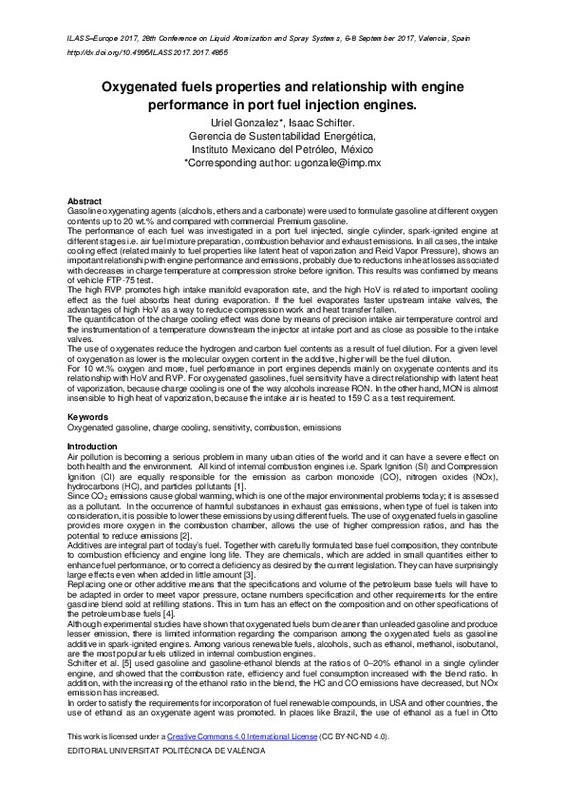JavaScript is disabled for your browser. Some features of this site may not work without it.
Buscar en RiuNet
Listar
Mi cuenta
Estadísticas
Ayuda RiuNet
Admin. UPV
Oxygenated fuels properties and its relationship with engine performance in port fuel injection engines
Mostrar el registro sencillo del ítem
Ficheros en el ítem
| dc.contributor.author | Gonzalez, Uriel
|
es_ES |
| dc.contributor.author | Schifter, Isaac
|
es_ES |
| dc.date.accessioned | 2018-04-12T11:24:37Z | |
| dc.date.available | 2018-04-12T11:24:37Z | |
| dc.date.issued | 2017-07-28 | |
| dc.identifier.isbn | 9788490485804 | |
| dc.identifier.uri | http://hdl.handle.net/10251/100302 | |
| dc.description.abstract | [EN] Gasoline oxygenating agents (alcohols, ethers and a carbonate) were used to formulate gasoline at different oxygen contents up to 20 wt.% and compared with commercial Premium gasoline. The performance of each fuel was investigated in a port fuel injected, single cylinder, spark-ignited engine at different stages i.e. air fuel mixture preparation, combustion behavior and exhaust emissions. In all cases, the intake cooling effect (related mainly to fuel properties like latent heat of vaporization and Reid Vapor Pressure), shows an important relationship with engine performance and emissions, probably due to reductions in heat losses associated with decreases in charge temperature at compression stroke before ignition. This results was confirmed by means of vehicle FTP-75 test. The high RVP promotes high intake manifold evaporation rate, and the high HoV is related to important cooling effect as the fuel absorbs heat during evaporation. If the fuel evaporates faster upstream intake valves, the advantages of high HoV as a way to reduce compression work and heat transfer fallen. The quantification of the charge cooling effect was done by means of precision intake air temperature control and the instrumentation of a temperature downstream the injector at intake port and as close as possible to the intake valves. The use of oxygenates reduce the hydrogen and carbon fuel contents as a result of fuel dilution. For a given level of oxygenation as lower is the molecular oxygen content in the additive, higher will be the fuel dilution. For 10 wt.% oxygen and more, fuel performance in port engines depends mainly on oxygenate contents and its relationship with HoV and RVP. For oxygenated gasolines, fuel sensitivity have a direct relationship with latent heat of vaporization, because charge cooling is one of the way alcohols increase RON. In the other hand, MON is almost insensible to high heat of vaporization, because the intake air is heated to 159 C as a test requirement. | es_ES |
| dc.format.extent | 9 | es_ES |
| dc.language | Inglés | es_ES |
| dc.publisher | Editorial Universitat Politècnica de València | es_ES |
| dc.relation.ispartof | Ilass Europe. 28th european conference on Liquid Atomization and Spray Systems | es_ES |
| dc.rights | Reconocimiento - No comercial - Sin obra derivada (by-nc-nd) | es_ES |
| dc.subject | Oxygenated gasoline | es_ES |
| dc.subject | Charge cooling | es_ES |
| dc.subject | Sensitivity | es_ES |
| dc.subject | Combustion | es_ES |
| dc.subject | Emissions | es_ES |
| dc.title | Oxygenated fuels properties and its relationship with engine performance in port fuel injection engines | es_ES |
| dc.type | Capítulo de libro | es_ES |
| dc.type | Comunicación en congreso | es_ES |
| dc.identifier.doi | 10.4995/ILASS2017.2017.4855 | |
| dc.rights.accessRights | Abierto | es_ES |
| dc.description.bibliographicCitation | Gonzalez, U.; Schifter, I. (2017). Oxygenated fuels properties and its relationship with engine performance in port fuel injection engines. En Ilass Europe. 28th european conference on Liquid Atomization and Spray Systems. Editorial Universitat Politècnica de València. 345-353. https://doi.org/10.4995/ILASS2017.2017.4855 | es_ES |
| dc.description.accrualMethod | OCS | es_ES |
| dc.relation.conferencename | ILASS2017 - 28th European Conference on Liquid Atomization and Spray Systems | es_ES |
| dc.relation.conferencedate | September 06-08,2017 | es_ES |
| dc.relation.conferenceplace | Valencia, Spain | es_ES |
| dc.relation.publisherversion | http://ocs.editorial.upv.es/index.php/ILASS/ILASS2017/paper/view/4855 | es_ES |
| dc.description.upvformatpinicio | 345 | es_ES |
| dc.description.upvformatpfin | 353 | es_ES |
| dc.type.version | info:eu-repo/semantics/publishedVersion | es_ES |
| dc.relation.pasarela | OCS\4855 | es_ES |








